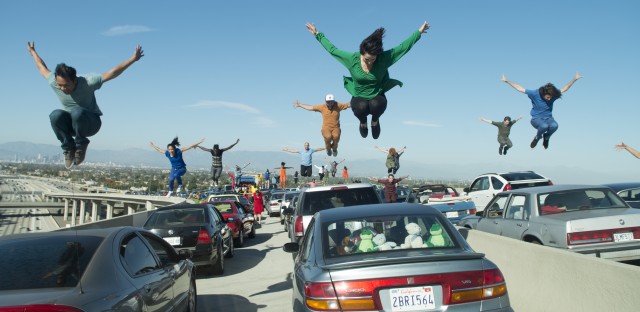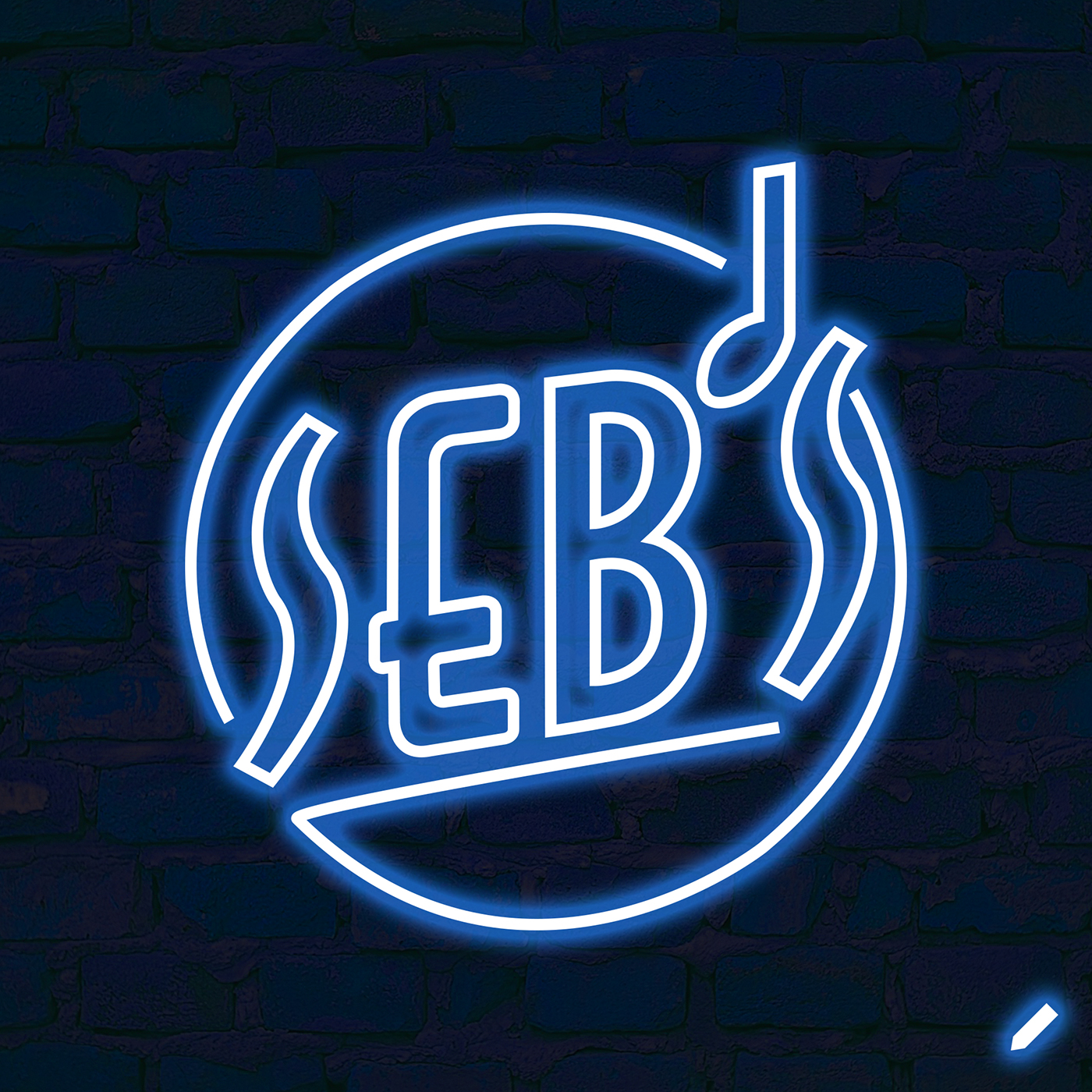← Back to Reviews
in
La La Land
Musicals appear to be making something of a comeback currently, so it is of no surprise that the recently released La La Land - nominated for twelve Oscars and winner of eleven BAFTAs - has been a major success for Lionsgate. That didn't stop me from naively assuming that an evening screening the night after the BAFTAs wouldn't be popular, of course. Thankfully I still managed to book seats the night before (even if they weren't the ones I'd hoped for), but at the time I was astonished at how many had been sold. In hindsight I probably should have seen it coming, but I hadn't been to a packed cinema in a while. La La Land was perhaps the biggest audience I'd been in for a film since 2012's film adaptation of Les Miserables.
La La Land tells the story of two aspiring lovers. Mia (Emma Stone), a waitress who works in a coffee shop, dreams of being a successful actress. Seb (Ryan Gosling) - a pianist who plays Christmas music at Lipton's restaurant - wants to open his own jazz club. Their paths first cross when Mia takes a shine to Seb's music, however their first encounter takes a rough turn when Seb rudely ignores Mia's approach and barges past. A chance encounter at an 80s-themed pool party where Seb is performing as part of an 80s tribute band leads to the beginning of their romance. But can the pair sustain their relationship with one another when Seb becomes part of a successful touring band, and subsequently spends a lot of time touring away from his partner?

The most important thing about a romantic movie is the chemistry between the main stars - and Emma Stone and Ryan Gosling have so much of it that you begin to wonder if they're secretly a couple in real life. This is the very definition of perfect casting for a romantic couple and it makes me glad that the original leads of Emma Watson and Miles Teller never happened. Whilst I am sure Emma Watson could have played the wide-eyed and innocent character of Mia, Miles Teller as the nostalgia-driven Seb I find much harder to imagine. Ryan Gosling is the perfect match for Seb; with just one look he gets across the character's unhappiness with the music he's playing as part of The Messengers, clearly doubting whether the old style of jazz he is nostalgic towards is still popular given the effect this very modern version of jazz music has on the crowd. With just one look at the end of the film (I won't spoil the ending for those of you who haven't seen it but it's not what you'd expect for a film like this) he gets across his feelings for Mia.

Emma Stone's Mia arguably goes on a bigger and more interesting journey than Seb however. Mia is a woman who views her romance with Seb almost as a fairytale fantasy; a type of escapism if you will from the real world, away from her failed auditions and towards something more exciting, and must learn that life is not a fairy tale and that in order to be the successful actress she desires to become she must accept the realities of the ‘real world’. Mia learns through her romance with Seb that being successful will mean she will have to deal with lengthy periods of time away from her husband and in screenwriting terms her ultimate sacrifice she has to make in order to achieve her dreams is her romantic relationship. Emma Stone does a good job of portraying this, although between the two Ryan Gosling is clearly gives the stronger performance.

I've talked a bit about the romance, but it's important not to forget that this is also a musical - and all good musicals need great songs. So, how do the songs shape up?
Well, there aren't as many songs as you would expect from a traditional musical - most of them are variations of the same song - but the songs featured in the movie are ridiculously catchy. My favourite is probably City of Stars. This song appears quite often throughout the film, but with good reason. It's a hummable, instantly recognisable tune that's impossible to get out of your head after hearing it once. Another favourite is the opening number Another Day of Sun, a lively song that echoes classic musicals like Little Shop of Horrors and Singin' In The Rain.
Speaking of Another Day of Sun, the routine to the song is perhaps one of the most colourful and vibrant openings to a musical ever. The way it turns something incredibly mundane (a gridlock of cars) into a bright, cheery moment echoes the brilliance of Singin' In The Rain's infamous dancing in the rain sequence. Hopefully it won't make people want to get out of their cars during a car journey and cause a massive gridlock just so they can copy the dance routine but it's a real crowd-pleaser and an excellent way to immediately grab your attention.

Songs such as Another Day of Sun and Someone In The Crowd are so seamlessly slotted into the screenplay that they don't feel out of place either. It helps that they're original songs unlike the music featured, say, in Mamma Mia but every song feels like it serves a purpose in the script. Another Day of Sun for instance directly foreshadows the ending of the movie, with lines such as
. Someone in The Crowd is sung by Mia's roommates as they try to persuade her to go to a party with them after Mia's failed audition. It flows naturally, and it's clear the director Damien Chazelle has taken inspiration from the excellent routines in Mamma Mia.

La La Land is a film that I imagine will become a permanent fixture on university courses. Take the cinematography by Linus Sandgren, for example. The cinematography is breath-taking, aided with some stunning visual effects. One of the most memorable scenes is in the planetarium, where Mia and Seb find themselves dancing through the stars and planets of space.

It is hands down the most visually impressive scene in any musical and with its broad use of colour brings to mind films popular with university lecturers such as The Red Shoes and the iconic Wizard of Oz.
The production design is also on-point, giving a sense of heavy nostalgia for the golden age of movie throughout the film. Movie posters for old Hollywood films dominate Mia's flat, costumes are very 'old' in style and the Lighthouse Cafe feels like it belongs in a 1930s musical.

Perhaps the best bit of production design is the logo Mia draws up for Seb's dream jazz club. It's a logo that makes a poignant return at the end of the film and is a very clever design, showcasing Mia's smart and inventive ideas. A lovely touch is a musical note used in place of an apostrophe; it feels exactly like the kind of logo you'd expect to see for a jazz club, adding to the film's believability.

Overall, La La Land is without a doubt a cinematic masterpiece. The chemistry between the lead actors is the most perfect it could have been and the broad sense of nostalgia towards the golden age of Hollywood comes to life in a satisfying way through the excellent production design. The cinematography is also on point, providing many scenes that are hugely satisfying on the big screen, and the screenplay effortlessly slips the songs into the story without any of them feeling out of place. This is a wonderful romantic story with an ending that plays well to the wants and needs of its characters. La La Land will go down in history as not only the best musical of the 2010s but also one of the best musicals of all time.
Musicals appear to be making something of a comeback currently, so it is of no surprise that the recently released La La Land - nominated for twelve Oscars and winner of eleven BAFTAs - has been a major success for Lionsgate. That didn't stop me from naively assuming that an evening screening the night after the BAFTAs wouldn't be popular, of course. Thankfully I still managed to book seats the night before (even if they weren't the ones I'd hoped for), but at the time I was astonished at how many had been sold. In hindsight I probably should have seen it coming, but I hadn't been to a packed cinema in a while. La La Land was perhaps the biggest audience I'd been in for a film since 2012's film adaptation of Les Miserables.
La La Land tells the story of two aspiring lovers. Mia (Emma Stone), a waitress who works in a coffee shop, dreams of being a successful actress. Seb (Ryan Gosling) - a pianist who plays Christmas music at Lipton's restaurant - wants to open his own jazz club. Their paths first cross when Mia takes a shine to Seb's music, however their first encounter takes a rough turn when Seb rudely ignores Mia's approach and barges past. A chance encounter at an 80s-themed pool party where Seb is performing as part of an 80s tribute band leads to the beginning of their romance. But can the pair sustain their relationship with one another when Seb becomes part of a successful touring band, and subsequently spends a lot of time touring away from his partner?

The most important thing about a romantic movie is the chemistry between the main stars - and Emma Stone and Ryan Gosling have so much of it that you begin to wonder if they're secretly a couple in real life. This is the very definition of perfect casting for a romantic couple and it makes me glad that the original leads of Emma Watson and Miles Teller never happened. Whilst I am sure Emma Watson could have played the wide-eyed and innocent character of Mia, Miles Teller as the nostalgia-driven Seb I find much harder to imagine. Ryan Gosling is the perfect match for Seb; with just one look he gets across the character's unhappiness with the music he's playing as part of The Messengers, clearly doubting whether the old style of jazz he is nostalgic towards is still popular given the effect this very modern version of jazz music has on the crowd. With just one look at the end of the film (I won't spoil the ending for those of you who haven't seen it but it's not what you'd expect for a film like this) he gets across his feelings for Mia.

Emma Stone's Mia arguably goes on a bigger and more interesting journey than Seb however. Mia is a woman who views her romance with Seb almost as a fairytale fantasy; a type of escapism if you will from the real world, away from her failed auditions and towards something more exciting, and must learn that life is not a fairy tale and that in order to be the successful actress she desires to become she must accept the realities of the ‘real world’. Mia learns through her romance with Seb that being successful will mean she will have to deal with lengthy periods of time away from her husband and in screenwriting terms her ultimate sacrifice she has to make in order to achieve her dreams is her romantic relationship. Emma Stone does a good job of portraying this, although between the two Ryan Gosling is clearly gives the stronger performance.

I've talked a bit about the romance, but it's important not to forget that this is also a musical - and all good musicals need great songs. So, how do the songs shape up?
Well, there aren't as many songs as you would expect from a traditional musical - most of them are variations of the same song - but the songs featured in the movie are ridiculously catchy. My favourite is probably City of Stars. This song appears quite often throughout the film, but with good reason. It's a hummable, instantly recognisable tune that's impossible to get out of your head after hearing it once. Another favourite is the opening number Another Day of Sun, a lively song that echoes classic musicals like Little Shop of Horrors and Singin' In The Rain.
Speaking of Another Day of Sun, the routine to the song is perhaps one of the most colourful and vibrant openings to a musical ever. The way it turns something incredibly mundane (a gridlock of cars) into a bright, cheery moment echoes the brilliance of Singin' In The Rain's infamous dancing in the rain sequence. Hopefully it won't make people want to get out of their cars during a car journey and cause a massive gridlock just so they can copy the dance routine but it's a real crowd-pleaser and an excellent way to immediately grab your attention.

Songs such as Another Day of Sun and Someone In The Crowd are so seamlessly slotted into the screenplay that they don't feel out of place either. It helps that they're original songs unlike the music featured, say, in Mamma Mia but every song feels like it serves a purpose in the script. Another Day of Sun for instance directly foreshadows the ending of the movie, with lines such as
WARNING: spoilers below
He'll sit one day, the lights are down. He'll see my face and think of how he used to know me - IE Seb in his new jazz club thinking about Mia and wondering what may have happened had they not grown apart

La La Land is a film that I imagine will become a permanent fixture on university courses. Take the cinematography by Linus Sandgren, for example. The cinematography is breath-taking, aided with some stunning visual effects. One of the most memorable scenes is in the planetarium, where Mia and Seb find themselves dancing through the stars and planets of space.

It is hands down the most visually impressive scene in any musical and with its broad use of colour brings to mind films popular with university lecturers such as The Red Shoes and the iconic Wizard of Oz.
The production design is also on-point, giving a sense of heavy nostalgia for the golden age of movie throughout the film. Movie posters for old Hollywood films dominate Mia's flat, costumes are very 'old' in style and the Lighthouse Cafe feels like it belongs in a 1930s musical.

Perhaps the best bit of production design is the logo Mia draws up for Seb's dream jazz club. It's a logo that makes a poignant return at the end of the film and is a very clever design, showcasing Mia's smart and inventive ideas. A lovely touch is a musical note used in place of an apostrophe; it feels exactly like the kind of logo you'd expect to see for a jazz club, adding to the film's believability.

Overall, La La Land is without a doubt a cinematic masterpiece. The chemistry between the lead actors is the most perfect it could have been and the broad sense of nostalgia towards the golden age of Hollywood comes to life in a satisfying way through the excellent production design. The cinematography is also on point, providing many scenes that are hugely satisfying on the big screen, and the screenplay effortlessly slips the songs into the story without any of them feeling out of place. This is a wonderful romantic story with an ending that plays well to the wants and needs of its characters. La La Land will go down in history as not only the best musical of the 2010s but also one of the best musicals of all time.
